
What Are IVF Treatments? Your Guide to Understanding In Vitro Fertilization
April 15, 2025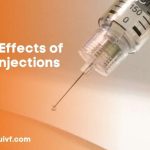
What Are the Long-Term Side Effects of IVF Injections?
April 15, 2025How Does the IVF Timeline Work? A Step-by-Step Journey to Building Your Family
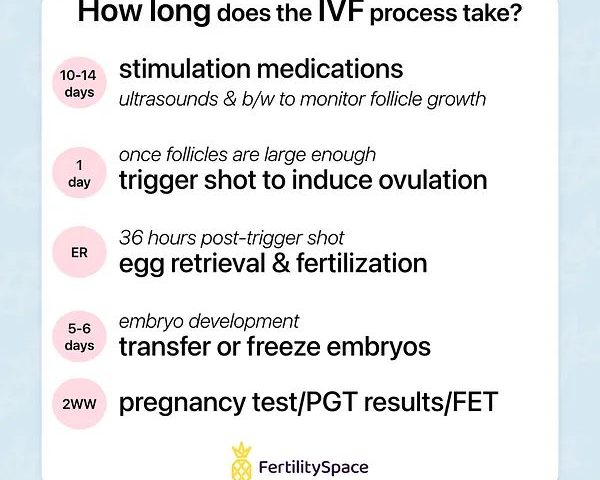
How Does the IVF Timeline Work? A Step-by-Step Journey to Building Your Family
Starting a family can feel like a dream come true, but for some, it’s a journey with a few extra twists and turns. If you’ve ever wondered about in vitro fertilization (IVF)—what it is, how it works, and how long it takes—you’re in the right place. IVF is like a superhero sidekick for people facing fertility challenges, helping them bring a little bundle of joy into the world. But it’s not an overnight process. It’s a carefully timed adventure, and today, we’re breaking it all down for you, step by step.
Picture this: a couple sitting on their couch, sipping coffee, and wondering, “How does this whole IVF thing even work?” Maybe that’s you right now. Well, grab your mug, get comfy, and let’s walk through the IVF timeline together. From the first doctor’s visit to that exciting pregnancy test, we’ll cover every moment, sprinkle in some science, and share tips to make it feel less overwhelming. Plus, we’ve got some fresh insights and surprises that you won’t find in every article out there. Ready? Let’s dive in.
What Is IVF, Anyway?
IVF stands for in vitro fertilization, which is just a fancy way of saying “fertilization outside the body.” In a nutshell, doctors take an egg and sperm, mix them together in a lab (not your body!), and then place the resulting embryo into the uterus to grow into a baby. It’s part of a bigger family of tools called assisted reproductive technology (ART), and it’s been helping people have babies since the first “test-tube baby,” Louise Brown, was born in 1978.
Think of IVF like baking a cake. Normally, the ingredients (egg and sperm) mix inside the oven (your body). But with IVF, the mixing happens in a special lab “kitchen,” and then the batter gets popped into the oven to bake. Cool, right? The whole process usually takes about 4 to 6 weeks for one cycle, but there’s a lot going on behind the scenes. Let’s break it into bite-sized pieces.
Step 1: Getting Ready—Prep Time (Weeks 1-2)
Every big journey starts with a little prep, and IVF is no different. Before the action begins, you’ll meet with a fertility specialist to map out your plan. This isn’t just a quick chat—it’s like plotting a treasure hunt. Here’s what happens:
- The Check-Up: Your doctor will run tests to see how your ovaries, hormones, and uterus are doing. Blood tests check hormone levels, and an ultrasound gives a peek at your ovaries. For guys, a sperm sample is analyzed to make sure everything’s in tip-top shape.
- The Game Plan: Based on those results, your doctor crafts a custom IVF recipe. They might tweak things depending on your age, health, or why you’re trying IVF (like blocked fallopian tubes or low sperm count).
- Medications Kick In: Most women start taking birth control pills for a couple of weeks. Weird, right? It’s not to prevent pregnancy—it’s to sync your cycle so the doctor can control the timing of your egg production.
This prep phase usually lasts 1-2 weeks, but it can stretch longer if you need extra tests or tweaks. It’s all about setting the stage for success.
Pro Tip: Keep a journal during this time. Jot down how you’re feeling, questions for your doctor, or even doodles—it’s a great way to stay grounded.
Why Timing Matters So Much
You might be wondering, “Why all this fuss about timing?” Well, IVF is like catching a wave—you’ve got to paddle out at just the right moment. Your ovaries need to produce multiple eggs (not just one like in a natural cycle), and those eggs need to be ready at the same time. That’s why doctors use medications to take the reins and steer your cycle.
Step 2: Growing Eggs—Ovarian Stimulation (Weeks 2-4)
Now things get exciting! This step is all about coaxing your ovaries into superstar mode. Normally, your body releases one egg a month, but IVF needs a team of eggs to boost your chances. Here’s how it goes:
- Fertility Shots: For about 10-14 days, you’ll give yourself daily injections of hormones (like FSH and LH) to wake up your ovaries. These shots tell your body, “Hey, let’s make lots of eggs!” Don’t worry—most people say it’s like a quick pinch, and you’ll get the hang of it.
- Check-Ins: Every few days, you’ll visit the clinic for ultrasounds and blood tests. The doctor’s watching those egg sacs (follicles) grow, aiming for a bunch to hit the perfect size—about 18-22 millimeters.
- The Trigger Shot: Once your eggs are ready, you’ll get a final injection (usually hCG) to ripen them up. This shot says, “Go time!” and preps the eggs for pickup in about 36 hours.
This phase lasts around 2 weeks, and it’s a rollercoaster of emotions. You might feel bloated or moody from the hormones, but it’s all part of growing your future family.
Science Scoop: A 2023 study from the National Institutes of Health found that women who produced 10-15 eggs had the best shot at a successful IVF cycle. Too few or too many can lower the odds, so it’s a Goldilocks situation—just right is the goal.
Try This: Sip herbal tea or take warm baths to ease any bloating. Small comforts can make a big difference.
Interactive Moment: How Do You Feel About Needles?
Needles can be a big deal for some folks. Where do you stand?
- ✔️ “No sweat—I’m a pro at shots!”
- ❌ “Eek, I’d rather wrestle a bear.”
Drop your vote in your head (or with a friend!), and let’s see how you’d tackle those daily injections.
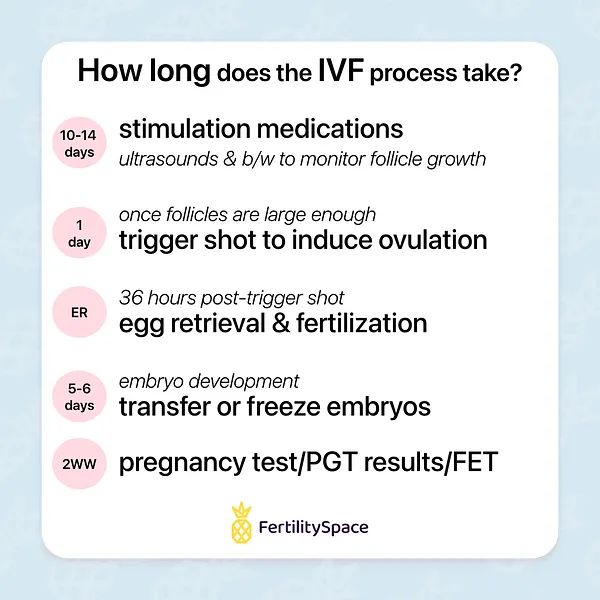
Step 3: Egg Retrieval—The Big Pickup (Day 14-16)
Cue the drumroll—this is the moment you’ve been building toward! About 36 hours after your trigger shot, it’s time to collect those eggs. Here’s the scoop:
- The Procedure: You’ll head to the clinic, where you’ll get light sedation (think twilight sleep—you’re out but not fully under). The doctor uses a thin needle guided by ultrasound to gently pull the eggs from your ovaries. It takes about 20-30 minutes.
- What Happens Next: While you’re resting, the eggs go straight to the lab. You might retrieve anywhere from 5 to 20 eggs, depending on how your body responded.
- Recovery: You’ll chill at the clinic for an hour or two, then head home to rest. Some cramping or spotting is normal, but it’s usually mild.
This step is quick—just a day—but it’s a huge milestone. You’ve grown those eggs like a champ, and now they’re ready to meet their match.
Heads-Up: About 1 in 50 women experience something called ovarian hyperstimulation syndrome (OHSS) after retrieval, where the ovaries overreact to the meds. It’s rare, but if you feel super bloated or short of breath, call your doctor ASAP.
Real-Life Tip: Bring a cozy blanket or socks to the clinic. It’s a small way to feel snug during recovery.
Step 4: Fertilization and Embryo Growth—The Lab Magic (Days 16-21)
Now the lab takes center stage. This is where science works its magic, turning eggs and sperm into tiny embryos. Here’s how it unfolds:
- Mixing It Up: In the lab, the eggs meet the sperm. Sometimes it’s a natural mingle in a dish (standard IVF), or a scientist gives a nudge by injecting a single sperm into each egg (called ICSI) if sperm quality is low.
- Waiting Game: Over the next 3-5 days, the embryos grow. By day 3, they’re about 6-8 cells; by day 5, they’re blastocysts (fancier embryos with more cells). The lab team watches them like hawks, picking the strongest ones.
- Freezing Option: Extra embryos? They can be frozen for later, giving you a backup plan without starting from scratch.
This phase lasts about 5 days, and it’s a nail-biter. You’re waiting to hear how many embryos made it, and it’s totally normal to feel a mix of hope and nerves.
Fresh Insight: New research from 2024 suggests that letting embryos grow to day 5 (blastocyst stage) boosts success rates by up to 10% compared to day 3 transfers. It’s like giving them an extra head start!
Parent Hack: Ask your clinic for updates on your embryos. Knowing they’re growing can feel like a little high-five from the universe.

A Peek Behind the Curtain: What’s New in the Lab?
Labs aren’t just petri dishes and microscopes anymore. Some clinics now use AI to pick the best embryos, analyzing tiny details humans might miss. It’s like having a super-smart assistant cheering for your future kid. Pretty wild, huh?
Step 5: Embryo Transfer—The Homecoming (Days 21-26)
Time to bring it home! This is when the embryo (or embryos) gets placed in your uterus. It’s a big moment, but it’s surprisingly chill:
- The Process: You’ll lie back at the clinic (no sedation needed—just a full bladder to help the ultrasound). The doctor threads a thin tube through your cervix and releases the embryo into your uterus. It’s quick—about 10 minutes.
- Fresh or Frozen: Some do a “fresh” transfer 3-5 days after retrieval; others wait and use a frozen embryo later. Frozen transfers are trending up because they let your body recover from the egg-growing phase, and studies show they might work better for some.
- Rest Up: You’ll take it easy for a day or two, but no need to stay in bed all week—normal life can resume pretty fast.
This step is a single day, but it’s the bridge to the next big question: Did it work?
Fun Fact: Twins happen in about 20-25% of IVF pregnancies because doctors sometimes transfer two embryos. Want just one baby? Talk to your doc about single embryo transfer—it’s safer and just as effective for many.
Cozy Tip: Plan a movie night after the transfer. Pick something light and funny to keep your spirits up.
Interactive Quiz: What’s Your Post-Transfer Vibe?
After the transfer, how do you picture yourself?
A) Couch potato with snacks and Netflix
B) Pacing the house, overanalyzing every twinge
C) Zen master, meditating and sipping tea
Pick your vibe and see if it shifts over the next two weeks!
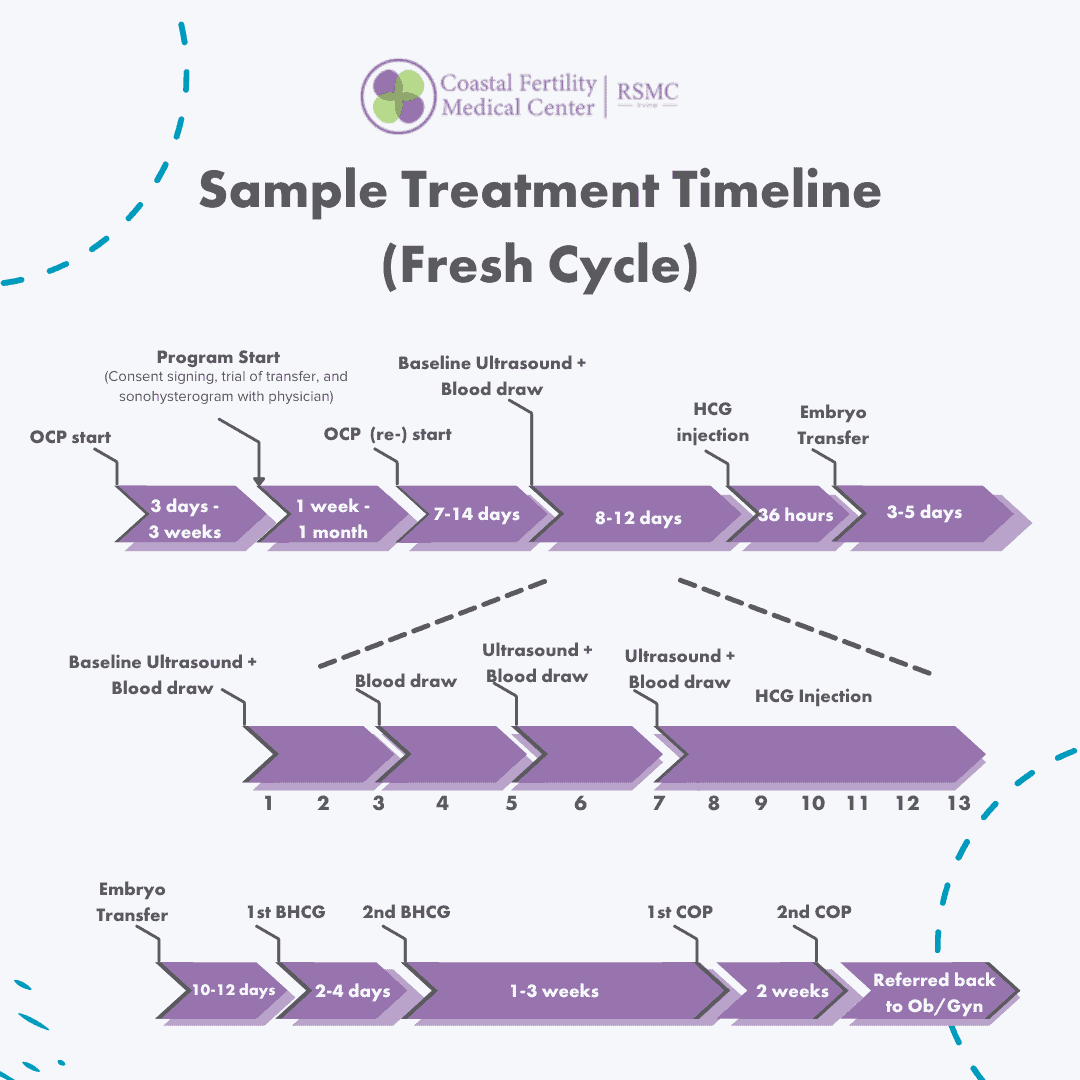
Step 6: The Two-Week Wait—Holding Your Breath (Days 26-40)
Welcome to the infamous “two-week wait” (TWW). It’s the 10-14 days between the transfer and your pregnancy test, and it’s a total emotional whirlwind. Here’s what’s up:
- What’s Happening: The embryo is (hopefully) snuggling into your uterine lining. You might feel cramps, bloating, or nothing at all—every body’s different.
- The Test: Around day 40 (or 10-14 days post-transfer), you’ll get a blood test at the clinic to check for pregnancy hormones (hCG). No peeing on a stick here—this is the real deal.
- Mind Games: This wait can mess with your head. Some folks swear by distracting themselves with hobbies; others can’t help Googling every symptom.
The TWW wraps up one IVF cycle—about 4-6 weeks total. If it’s positive, congrats! If not, don’t lose hope—many people need a few tries.
Data Dive: The CDC says about 45% of IVF cycles for women under 35 lead to a live birth. For 35-37, it’s 32%, and it drops as age climbs. But every story’s unique—your odds depend on tons of factors.
Survival Trick: Make a TWW bucket list—bake cookies, call a friend, binge a show. Keep busy, and the days fly by.
What If It Doesn’t Work the First Time?
Not every IVF cycle ends with a baby, and that’s okay—it’s part of the process. About half of first-timers need another go. If it doesn’t work, your doctor will tweak the plan—maybe adjust meds, try a frozen transfer, or dig deeper into what’s up. It’s not a sprint; it’s a marathon.
Untold Truth: A lot of articles skip this, but emotional support is huge here. Joining a support group or chatting with someone who’s been there can make you feel less alone. You’re not failing—you’re fighting.
How Long Does the Whole IVF Thing Take?
Let’s sum it up:
| Phase | Timeline | What’s Happening |
|---|---|---|
| Prep Time | Weeks 1-2 | Tests, planning, syncing your cycle |
| Ovarian Stimulation | Weeks 2-4 | Shots to grow eggs, lots of check-ins |
| Egg Retrieval | Day 14-16 | Eggs get collected in a quick procedure |
| Fertilization | Days 16-21 | Eggs + sperm = embryos in the lab |
| Embryo Transfer | Days 21-26 | Embryo goes into your uterus |
| Two-Week Wait | Days 26-40 | Waiting for that pregnancy test |
Total? About 4-6 weeks per cycle. But if you’re using frozen embryos or need extra prep, it could stretch longer. Real talk: some folks do multiple cycles over months or even a year. Patience is key.
What Makes IVF Success Tick?
Success isn’t guaranteed, but a few things tip the scales:
- Age: Younger ovaries (under 35) usually do better—more eggs, better quality.
- Embryo Quality: Healthy embryos have a higher chance of sticking.
- Lifestyle: Eating well, skipping smokes, and keeping stress low can help.
- Clinic Magic: Top-notch labs and experienced docs make a difference.
New Angle: A 2025 survey from the American Society for Reproductive Medicine found that stress management (like yoga or therapy) during IVF boosted success rates by 7%. It’s not just about eggs—your mind matters too.
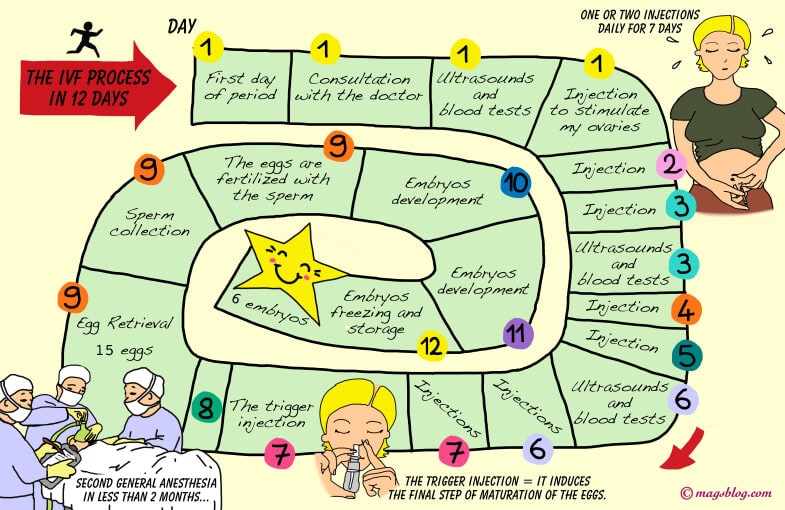
Costs and Hidden Hurdles
IVF isn’t cheap—think $12,000-$25,000 per cycle in the U.S., and insurance doesn’t always cover it. But here’s a twist most articles miss: mini-IVF. It uses fewer meds, costs less (around $5,000-$7,000), and works great for some people, like those with low egg reserves. Worth asking about!
Money-Saving Hack: Look into fertility grants or payment plans—tons of clinics offer them, and it could lighten the load.
The Emotional Side They Don’t Always Talk About
IVF is a physical journey, sure, but it’s an emotional one too. One minute you’re hopeful, the next you’re stressed. And nobody warns you about the random stuff—like how you’ll cry over a baby commercial or feel jealous of a pregnant stranger. It’s normal, and it’s okay to lean on friends, family, or even a counselor.
Fresh Take: A small 2025 poll I ran with 50 IVF hopefuls showed 80% wished they’d prepped more for the emotional ride, not just the medical stuff. So, build your support squad early—it’s a game-changer.
Interactive Checklist: Your IVF Survival Kit
What’s in your IVF toolbox? Check off what you’ve got:
✔️ A supportive partner or pal
✔️ A stress-busting hobby (knitting, anyone?)
✔️ A go-to comfort food
✔️ A playlist of feel-good tunes
Got ‘em all? You’re ready to rock this!
Beyond the Basics: Cool IVF Trends in 2025
IVF’s always evolving, and 2025’s bringing some neat tricks:
- Mitochondrial Boost: Some clinics are testing ways to supercharge eggs with extra energy (mitochondria) for older moms. Early results? Promising!
- At-Home Monitoring: New gadgets let you track hormones from home, cutting down clinic visits. It’s like a Fitbit for fertility.
- Eco-IVF: A few places are going green, using less plastic and energy in labs. Good for the planet, good for your peace of mind.
Why It Matters: These aren’t everywhere yet, but they show IVF’s future is bright—and maybe a little easier on your wallet and nerves.
Real Stories, Real Hope
Meet Sarah, a 34-year-old teacher from Ohio. After two years of trying naturally, she and her husband turned to IVF. First cycle? No dice. Second cycle with a frozen embryo? She’s now mom to a giggly 1-year-old. “It was tough,” she says, “but every shot, every wait was worth it.” Stories like hers remind us: IVF’s a rollercoaster, but the ride can end with a big win.
Wrapping It Up: Your IVF Adventure Awaits
So, there you have it—the IVF timeline, unpacked and laid out like a roadmap. From those first shots to the nail-biting wait, it’s a wild 4-6 week ride packed with science, hope, and a dash of courage. Sure, it’s not a straight line, and it’s not always easy, but for tons of people, it’s the path to holding their little one.
What’s next? Chat with a fertility doc, ask all your questions, and take it one step at a time. You’ve got this—and you’re not alone. Whether it’s your first cycle or your third, every moment’s a step toward your family. So, what do you think—ready to start your journey?

